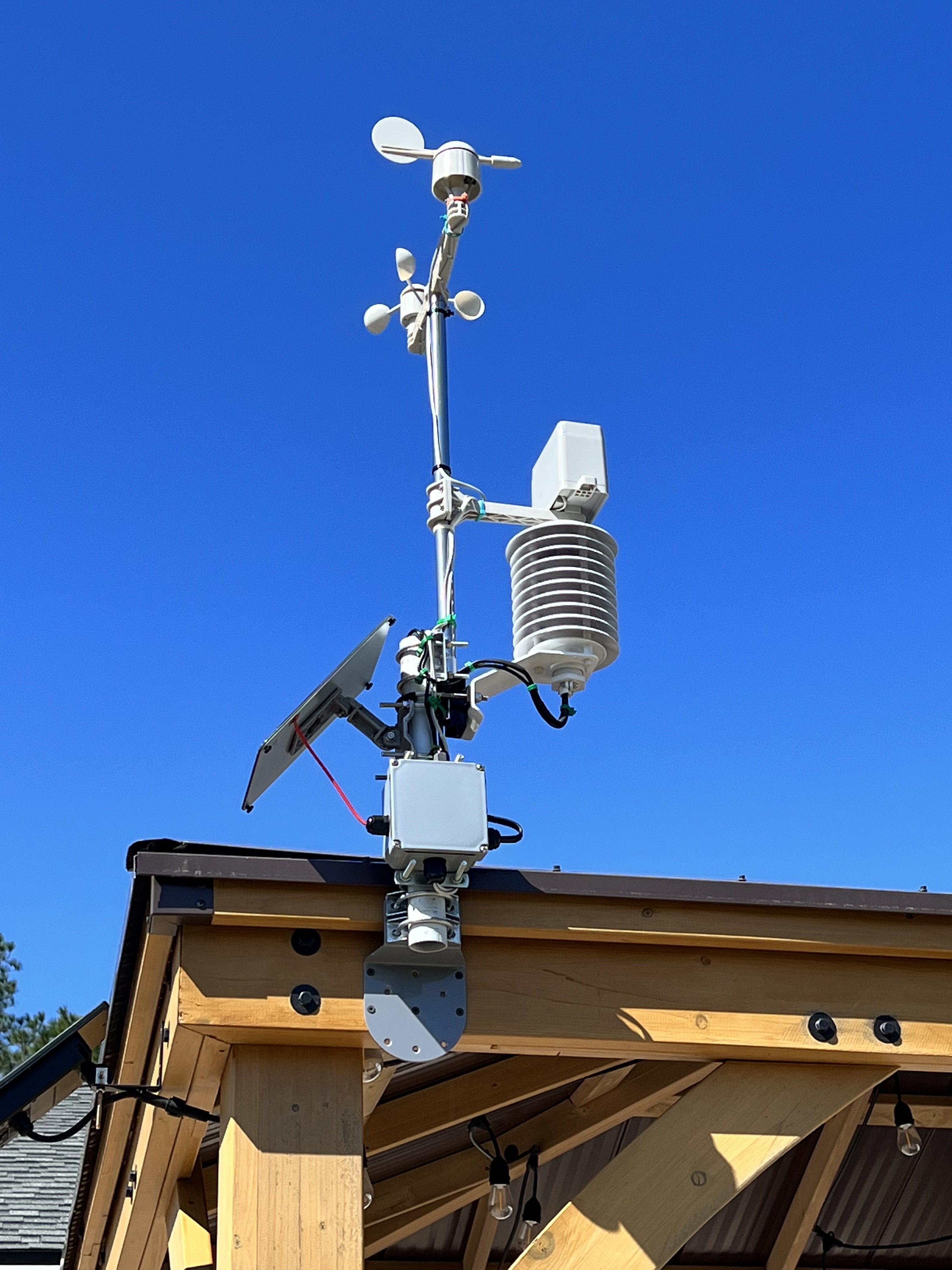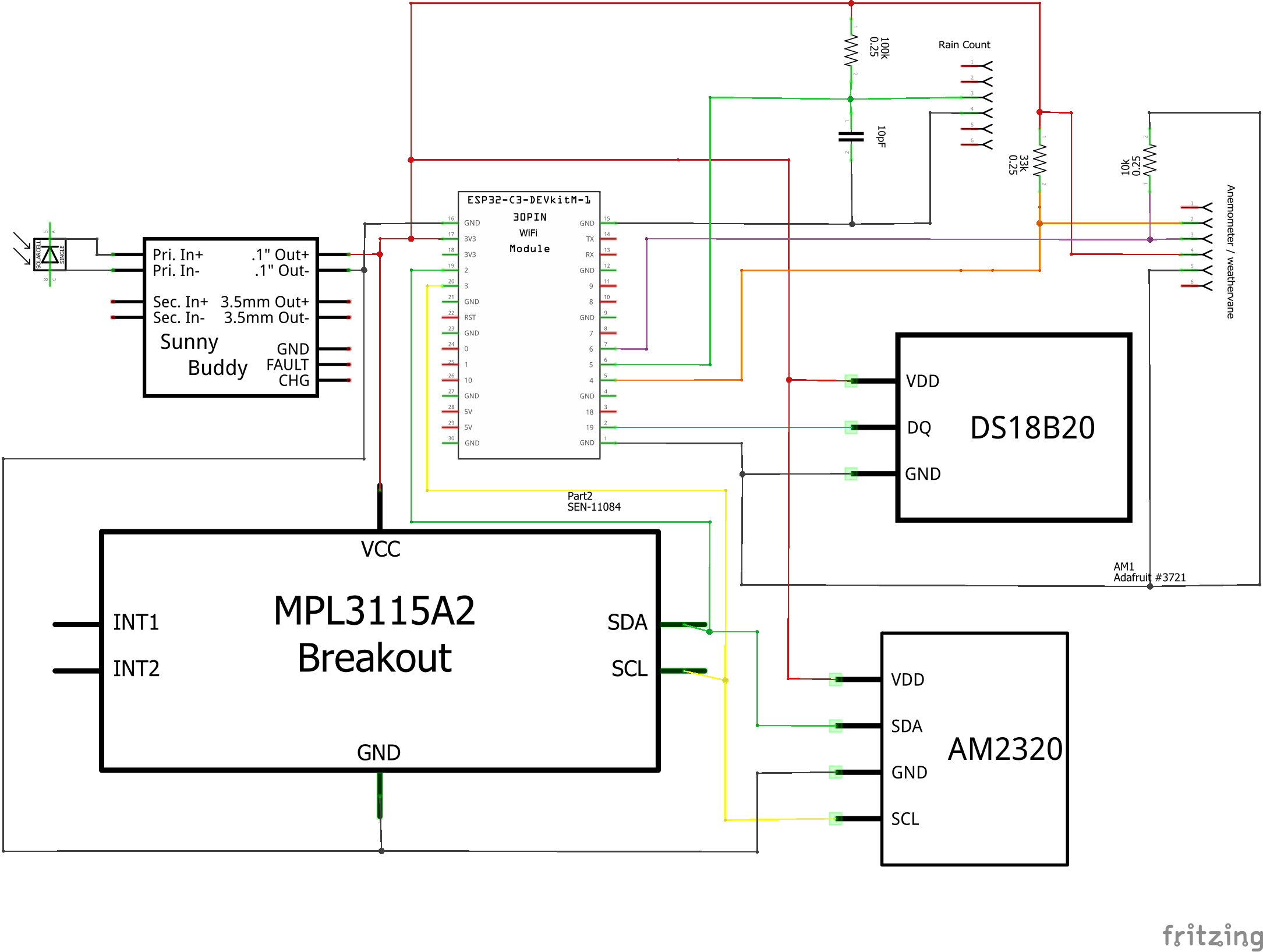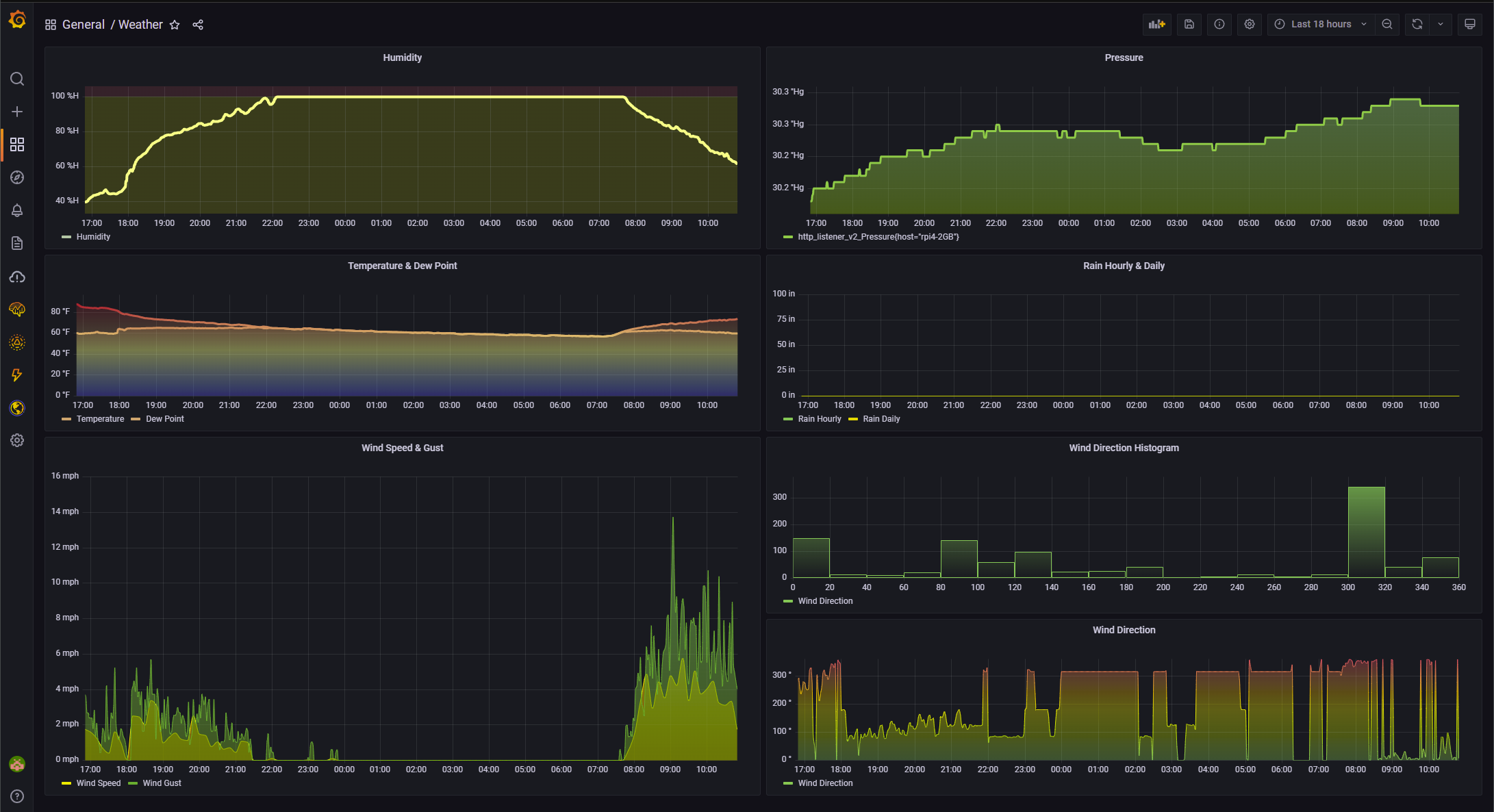☁️ 🌀 🌊 ⚡ ☀️ ☔ ⛄ 🌁
This project is powered by a solar panel that charges a lithium ion battery through a Sparkfun "solar buddy" board. The code is written in MicroPython on an ESP32-C3-Mini. The microcontroller collects data from the rain, wind (speed & direction), humidity, pressure, and temperature sensors in a variety of ways (i.e. i2c, oneWire, ADC, and electrical pulse interrupts). The data is collected every 5 seconds, then averaged at the end of two minutes and placed into a dictionary data structure. The dictionary is converted to JSON and sent to my Wunderground PWS site https://www.wunderground.com/dashboard/pws/KFLJACKS4049 where my data and other users data get stored for public consumption. There is a Telegraf listener running in a docker container on my local network (repo for docker telegraf-influxdb-grafana stack -> https://github.com/jcksnvllxr80/docker-telegraf-influx-grafana) which takes JSON requests via API and converts the data into a protocol that influxDb speaks. There are two Telegraf outputs; one goes to the local influxdb running in docker and the other goes to a Prometheus plugin running in my Grafana Cloud account. Both databases allow me to make beautiful charts and graphs to show and analyze the weather data. All connections to the network are via Wi-Fi connection on my Google Wifi (Mesh) LAN.
The following classes (which are all in this repo) must be manually loaded onto the esp32-c3 for this project to work (main.py also necessary):
- conf directory with 'config.json' inside... use the example i provided (will need to use an online converter to base64 encode your ssid and password)
base64.pytime_utils.pyhttp_utils.pyapi_utils.pymrequests.pyweather.pyam2320.pympl3115a2.py
- download and unzip https://github.com/espressif/esptool
- download the MicroPython firmware https://micropython.org/download/esp32c3/ (esp32c3-20220618-v1.19.1.bin)
- for the next step I used anaconda prompt (you may have to install dependencies)
- python esptool.py --chip esp32c3 --port COM<your_com_num> erase_flash
- python esptool.py --chip esp32c3 --port COM<your_com_num> -b 1500000 --baud 460800 write_flash -z 0x0 esp32c3-20220618-v1.19.1.bin
- the above two commands worked for me but here is a helpful link just in case: http://embedded-things.blogspot.com/2021/10/flash-micropython-firmware-on-esp32-c3.html
- add ability to take asynchronous requests over network via API so that local nagios can query weather status
- get a UV sensor
| Dir | Ri | Vi | Angle | R | Vo | ADC |
|---|---|---|---|---|---|---|
| N | 33000 | 3.3 | 0 | 33000 | 1.650 | 2335 |
| N/NE | 33000 | 3.3 | 22.5 | 6570 | 0.548 | 930 |
| NE | 33000 | 3.3 | 45 | 8200 | 0.657 | 925 |
| E/NE | 33000 | 3.3 | 67.5 | 891 | 0.087 | 123 |
| E | 33000 | 3.3 | 90 | 1000 | 0.097 | 140 |
| E/SE | 33000 | 3.3 | 112.5 | 688 | 0.067 | 300 |
| SE | 33000 | 3.3 | 135 | 2200 | 0.206 | 294 |
| S/SE | 33000 | 3.3 | 157.5 | 1410 | 0.135 | 190 |
| S | 33000 | 3.3 | 180 | 3900 | 0.349 | 494 |
| S/SW | 33000 | 3.3 | 202.5 | 3140 | 0.287 | 1516 |
| SW | 33000 | 3.3 | 225 | 16000 | 1.078 | 1525 |
| W/SW | 33000 | 3.3 | 247.5 | 14120 | 0.989 | 1400 |
| W | 33000 | 3.3 | 270 | 120000 | 2.588 | 3706 |
| W/NW | 33000 | 3.3 | 292.5 | 42120 | 1.850 | 2625 |
| NW | 33000 | 3.3 | 315 | 64900 | 2.188 | 3101 |
| N/NW | 33000 | 3.3 | 337.5 | 21880 | 1.316 | 1866 |
learn more here: https://support.weather.com/s/article/PWS-Upload-Protocol?language=en_US
https://weatherstation.wunderground.com/weatherstation/updateweatherstation.php?ID=KCASANFR5&PASSWORD=XXXXXX&dateutc=2000-01-01+10%3A32%3A35&winddir=230&windspeedmph=12&windgustmph=12&tempf=70&rainin=0&baromin=29.1&dewptf=68.2&humidity=90&weather=&clouds=&softwaretype=vws%20versionxx&action=updateraw
GET parameters
NOT all fields need to be set, the _required_ elements are:
ID
PASSWORD
dateutc
IMPORTANT all fields must be url escaped
reference http://www.w3schools.com/tags/ref_urlencode.asp
example
2001-01-01 10:32:35
becomes
2000-01-01+10%3A32%3A35
if the weather station is not capable of producing a timestamp, our system will accept "now". Example:
dateutc=now
list of fields:
action [action=updateraw] -- always supply this parameter to indicate you are making a weather observation upload
ID [ID as registered by wunderground.com]
PASSWORD [Station Key registered with this PWS ID, case sensitive]
dateutc - [YYYY-MM-DD HH:MM:SS (mysql format)] In Universal Coordinated Time (UTC) Not local time
winddir - [0-360 instantaneous wind direction]
windspeedmph - [mph instantaneous wind speed]
windgustmph - [mph current wind gust, using software specific time period]
windgustdir - [0-360 using software specific time period]
windspdmph_avg2m - [mph 2 minute average wind speed mph]
winddir_avg2m - [0-360 2 minute average wind direction]
windgustmph_10m - [mph past 10 minutes wind gust mph ]
windgustdir_10m - [0-360 past 10 minutes wind gust direction]
humidity - [% outdoor humidity 0-100%]
dewptf- [F outdoor dewpoint F]
tempf - [F outdoor temperature]
* for extra outdoor sensors use temp2f, temp3f, and so on
rainin - [rain inches over the past hour)] -- the accumulated rainfall in the past 60 min
dailyrainin - [rain inches so far today in local time]
mine will look more like this:
https://weatherstation.wunderground.com/weatherstation/updateweatherstation.php?ID=my_id&PASSWORD=my_key&dateutc=now&winddir=230&windspeedmph=12&windgustmph=12&tempf=70&rainin=0&dailyrainin=0&softwaretype=custom&action=updateraw
Use Thonny to write some code to ESP32-C3-Mini: example below where i was testing the temp sensor.
# 1-wire DS18B20
import machine, onewire, ds18x20, time
ds_pin = machine.Pin(19)
ds_sensor = ds18x20.DS18X20(onewire.OneWire(ds_pin))
roms = ds_sensor.scan()
print("Found ds18x20 devices: {}".format(roms))
ds_sensor.convert_temp()
time.sleep_ms(750)
for rom in roms:
print(ds_sensor.read_temp(rom))






